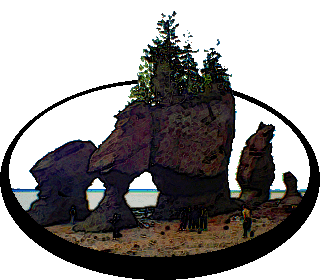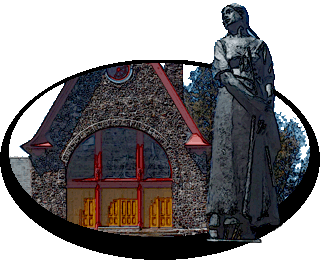
Six Ways To Fundy


8 May 2022
The North Atlantic Arc Home
| May |
| S | M | T | W | T | F | S |
| 5 | 6 | 7 | ||||
| 8 | 9 | 10 | 11 | 12 | 13 | 14 |
| 15 | 16 | 17 | 18 | 19 | 20 | 21 |
| 22 | 23 | 24 |
 |
|
Sunday 8 May 2022--Saint John has a long and proud maritime history. It's
still Canada's third largest commercial port of entry, despite losing much of its
traffic when the St Lawrence Seaway opened. It was for many decades a
premier shipbuilding city. Saint John Shipbuilding was the largest shipyard in
the country before it closed early in this century. The yard built corvettes
during WWII, and Halifax-class frigates in the '90s, as well as tankers for the
parent Irving company. In 1971, it launched the Princess of Acadia, a roll on-roll
off ferry for the Saint John-Digby route. That's the vessel I rode in 2012, and
also on a motorcycle trip in the '80s. It was scrapped in 2015, replaced by a
second-hand vessel purchased from Greece, renamed the Fundy Rose. It had
been launched in South Korea in 2000. That is the ship I board this morning.
The crossing takes about two hours. From the terminal, just outside Digby, I drive the minor road back toward the Fundy shore to visit the Point Prim Light*. (The link for this and other lights is to Kraig Anderson's excellent Lighthouse Friends website, which documents virtually every lighthouse in North America.) This is the fourth light on this site, the earliest dating to 1804, the third-earliest in Nova Scotia. It's an important spot, guiding ships into Digby Gut, despite which dozens of wrecks were recorded in the 19th and early 20th centuries. It's noted on one of the information panels here that when the third light had outlived its usefulness in 1963, it was simply pushed over the cliff by a bulldozer, a demolition method that I think would be frowned on today. I stop in Digby for a stroll along Water Street. The town was named for Rear Admiral Robert Digby, who arrived in 1783 with 1200 Loyalists. Promises of support by the Crown were not fully honored, and early days were difficult. But the new settlers quickly discovered the bounty offered by the Bay of Fundy, and fishing is the backbone of the local economy to this day. Digby was a lunch stop on one of the bus tours I drove, and I've never spent more than a couple of hours here. My impressions of the town have varied--it's certainly a beautiful setting, on the lovely Annapolis Basin, but empty storefronts along Water Street always seemed to indicate an economy that wasn't quite making it. The place seemed much livelier when I passed through in 2012, and I thought this year that a night's stay would give me a better sense of it. Circumstance led me to scrap that, and that's too bad, I guess; but walking up and down the street today, I don't have the feeling that I'm missing out on very much. Annapolis Royal, where I'm staying tonight, is only about twenty miles down the road, and I'm in no hurry as I leave Digby. I remember that you have to stay on the main highway to cross Joggin Bridge, after which I get on the old Route 1, forgetting that you also need to be on the 101 to cross Bear River. I end up at the village of Bear River, four miles upstream. I've never been here--didn't know it existed, actually--and it looks fairly charming, a bit hippie-ish, maybe. What I missed by not staying in Digby, I realize, was a day of exploring the surrounding area. I continue on a while, pleasantly slightly lost, before deciding that I need to get to where I'm going, and engaging the car's GPS (which I rarely use) to get me back on track. I'm at my lodgings, a motel just outside town, mid-afternoon. After a short nap (almost inevitable after an early start), I drive the short distance into town, park, and have a stroll around the old earthworks of Fort Anne. A company of Scots led by William Alexander built Charles Fort here in 1629. The settlement didn't last long, as the territory was ceded back to the French in 1632, but it was the foundation of New Scotland. The French re- established Port Royal (more about which tomorrow) here, as the capital of Acadie. A plaque on the grounds lauds the leadership of our pal d'Aulnay, without mentioning what a rat bastard he was. The British took the site back in 1710, renaming it in honor of Queen Anne, and it served as Nova Scotia's capital until the founding of Halifax in 1749. The earthworks still here are from the French regime, as is, I believe, the powder magazine; the only other surviving structure is the officers' quarters, British-built in 1797. The adjacent Garrison Cemetery holds the oldest English tombstone in Canada, dated 1720. There are no visible remains of French burials, going back almost a century earlier. Pop into the Annapolis Brewing Company for a pint or two, and presently find myself in conversation with Paddy, the talkative bartender. Among many other things, he tells me he once lived in Peggys Cove, and he mentions the improvements made to the infrastructure there, just this past year. I wasn't sure I wanted to bother making the trip there out of Halifax, where I'll be staying next week; I've been to Peggys Cove many times. But he's piqued my curiosity. All at once, I realize it's getting late, and there's some doubt about getting dinner. Paddy suggests the Whiskey Teller. I'm in luck, and dinner is excellent. Next * Years ago, I learned that a light with living quarters for a keeper is called a lighthouse; a structure lacking such quarters is simply a light. No one seems to make that distinction anymore, not even Mr Anderson, the keeper of the above-linked website, or for that matter any of the on- line definitions I can find. I suppose it's partly because there are no keepers anymore, so that the distinction is irrelevant; and partly because "lighthouse" is semantically not so ambiguous as "light". Or maybe I'm just wrong. Nevertheless, I persist, perhaps at least occasionally in error. |
Saint John to Annapolis Royal
 |
MV Fundy Rose
 |
Farewell Saint John
 |
Victoria Beach
 |
Digby Gut
 |
Point Prim Lighthouse
 |
Point Prim
 |
Point Prim
 |
Digby
 |
Digby
 |
Fort Anne
 |
Fort Anne
 |
Fort Anne
 |
Fort Anne
 |
Fort Anne
 |
Fort Anne
 |
Fort Anne
 |
Garrison Cemetery
 |
Annapolis Brewing Company
 |
Annapolis Brewing Company
 |
Annapolis Royal Lighthouse
Next
| May |
| S | M | T | W | T | F | S |
| 5 | 6 | 7 | ||||
| 8 | 9 | 10 | 11 | 12 | 13 | 14 |
| 15 | 16 | 17 | 18 | 19 | 20 | 21 |
| 22 | 23 | 24 |
The North Atlantic Arc Home

Mr Tattie Heid's Mileage
Results may vary
MrTattieHeid1954@gmail.com